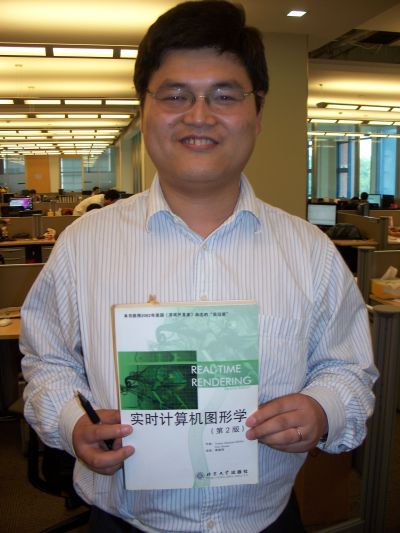A few days before the official release date of July 1, the book GPU Pro is out. Think “ShaderX, but now with color”. The example programs and source code are free to download. As mentioned before, more about it at Wolfgang Engel’s book blog.
Category Archives: Miscellaneous
Conference Schedule Followup
Last month I noted some resources for finding out about graphics conference due dates and meeting dates. Naty pointed out that we, in fact, host one ourselves, by Ke-Sen Huang. Other people noted this nice one and this detailed one.
I’m posting today because Yamauchi Hitoshi has updated his own conference calendar (due to suggestions from readers of this blog), and also made the generator free software. He originally just made this page for himself, but the power of the web and all that… I like the layout a lot. The visual presentation of deadlines, notifications, and actual conference date is (I imagine) quite useful for deciding where to submit a paper and what alternatives there are if it is not immediately accepted.
Shanghai 3D
Some computerish graphicsy photos from my trip to Shanghai. First, they’ve got the right definition of 3D:
But what about Cartesian coordinates? This pavilion certainly predates those, definitely 3D:
A cool sculpture from the World Expo (Robin Green comments “…hsync timing issues”):
Thomas, a happy customer of our 2nd edition:
Given the number of “name-brand” watches, purses, clothing, software, etc. in the (literally underground) market at the Shanghai Science and Technology Museum metro stop, name infringement like this is very small potatoes:
Magical technology from this market, no doubt shipped back from the future: USB flash drives with up to 880 GB!
Near as we can tell, they hack the driver on a small flash drive to make it look like 880 GB or whatever to your computer. Think of them as “write-only USBs”. Just as well: if you were to try to fill a real drive of this size at its 7 MB/sec transfer rate, it would take 35 hours.
Martin Gardner, a great person
Some have heard, some haven’t, so I’ll mention it here: Martin Gardner passed away a few days ago, age 95. If you’re saying “who?”, then you’re in for a treat, as there’s a great set of books and articles you haven’t yet discovered. He wrote about mathematical ideas and puzzles (he popularized Conway’s Game of Life, among many other things), debunked pseudoscience such as homeopathy and dianetics, explained magic tricks, annotated Lewis Carroll’s works and others, wrote about science and a little philosophy – what a great guy, and my #1 childhood hero. Need to know more? Check say this NYT article (which includes some puzzles) and Wikipedia.
I just noticed on Amazon you can get all of his Scientific American “Mathematical Games” articles on CD-ROM – cool. Me, my favorite books are “Aha! Insight” and “Aha! Gotcha” because I could give them to my children and pass on the word.
I’ll get back to graphics soon, but for now: a toast to a life well lived, and may we all do at least half as well!
Oh, come to think of it, I do have something that’s somewhat graphical, or at least geometric. This is from the book “The Mathemagician and Pied Puzzler: a Collection in Tribute to Martin Gardner”: You have a cube and you select at random three (different) corners. What is the chance that the triangle formed by these corners is acute (all angles < 90 degrees)? is a right triangle (has one angle == 90 degrees)?
Answers are here, along with another puzzle.
Bonus followup: I just noticed that the book I mentioned, “The Mathemagician…”, is available as a free PDF download.
Graphics Conference Calendars
SIGGRAPH’s early registration deadline is June 4th, after that the price goes up $175 or so, depending. News of which made me look around for graphics conference calendars. I didn’t find much – if anyone knows of others, please do let me know.
The Upcoming Graphics Conferences page on wikidot lists most of the graphics conferences I know about, and tons I don’t. It doesn’t list HPG 2010, however. I wrote the website maintainer about this omission but it’s a week later and no response or update.
A handy schedule of computer graphics conferences is available from a student at the Max Planck Institute. This one’s handy for researchers, as it gives submission dates. Oddly, HPG 2010 is again missing.
SIGGRAPH 2010 Course Scheduling
One of the challenges of SIGGRAPH is doing it all. My own method is to take a sheet of lined paper (remember that stuff?) and make columns for the days, each line being a half hour. One whole sheet holds it all, vs. me dorking around with my Palm/phone/Touch/whatever, scrolling around to see what’s what. Old school, but it works great.
Anyway, Naty’s recent summary of courses didn’t have course times. Here goes, mostly for my own benefit, in time order. Bolded are the ones I personally plan to attend and why, FWIW:
Perceptually Motivated Graphics, Visualization, and 3D Displays – Sunday afternoon
Physically Based Shading Models in Film and Game Production – Sunday afternoon. Toss up for me between this and the previous course. Naty’s the only speaker for this one, so it’s tempting to go, just to see his head explode after lecturing for 3+ hours.
Stylized Rendering in Games – Monday morning. I’m particularly pumped for this one, having done NPR work this last year.
Recent Advances in Real-Time Collision and Proximity Computations for Games and Simulations – Monday afternoon
Color Enhancement and Rendering in Film and Game Production – Tuesday morning. Naty’s a speaker.
Filtered Importance Sampling for Production Rendering – Tuesday morning
An Introduction to 3D Spatial Interaction With Videogame Motion Controllers – Tuesday afternoon
Advances in Real-Time Rendering in 3D Graphics and Games – all Wednesday. Traditional course, usually quite good.
Volumetric Methods in Visual Effects – Wednesday morning
Gazing at Games: Using Eye Tracking to Control Virtual Characters – Wednesday afternoon
Beyond Programmable Shading – all Thursday. The DICE talk last year was amazing, the others were also worthwhile.
Advanced Techniques in Real-Time Hair Rendering and Simulation – Thursday morning
Global Illumination Across Industries – Thursday afternoon
The “Advances” course used to always be Monday. Which was terrible last year, as it was scheduled against the last day of the colocated HPG conference (not a problem this year, since HPG is in Europe alternate years). I suspect someone realized that putting Advances and Beyond next to each other, and alongside the exhibition floor days, was good for pulling in game devs. Anyway, looks to be a great set of courses, other than the risk of head explosion.
If you want something lighter to start with on Sunday, try Glassner’s “Processing for Visual Artists and Designers” course. The Processing language is easy to learn and fun for quick bit-twiddling or other 2D effects, with all the usual 2D primitives and mouse support (and much else) built in.
Voting Time!
If you’re an ACM member, this is a reminder that the ACM 2010 Council Election voting deadline is noon (EDT) on May 24th. So vote now. You’ll need the piece of paper mailed to you, along with your ACM membership number (find that here or look at the label of a CACM sent to you, if you don’t recall it). Voting itself takes a minute, tops. While you’re at it, vote in the ACM SIGGRAPH elections – deadline is June 4th. Who to vote for? Here’s Naty’s take. Disappointingly, very few candidates have responded so far to his questionnaire (a few candidates’ email addresses could not even be found, which is pretty sad).
I find voting theory fascinating, since there’s no perfect way to set up voting when there are more than two candidates, to name just one dilemma. I just noticed this book on Amazon, which I’ve put on reserve at the library – Poundstone’s books are usually entertaining.
ACM and SIGGRAPH Members – Vote for Open Access!
Long-time readers of this blog will be well aware of my position on ACM and Open Access. Although ACM is a non-profit organization which ostensibly has as its only mandate “the advancement of computing as a science and a profession”, the ACM Publications Board has been behaving like a rent-seeking publisher; bullying students working to provide valuable resources to the community, and lobbying the US Government against Open Access initiatives, all in the name of protecting their revenue streams.
I have witnessed an outpouring of anger from the computing community at these events, convincing me that I am not alone in believing that the ACM Publications Board (and by extension the ACM itself) has tragically lost its way, prioritizing its income over the good of computing as a science and a profession. In fighting Open Access they are on the wrong side of history; witness all the leading academic institutions who have come out in favor of the very government Open Access initiative which the ACM has opposed.
If you believe as I do, then now is the chance to make a difference! SIGGRAPH is holding elections now for three Director-at-Large positions, to be selected from five candidates; the deadline for the elections is June 4th. If you are an active SIGGRAPH member, you should have received instructions for voting by now; you can vote at this link. ACM is also holding general elections for various Council positions, including the President of the ACM; you can vote at this link. The deadline for the ACM General Council elections is May 24th.
For me, Open Access is the most important issue in these elections. But which candidates will fight for Open Access, and which for the status quo? Of all the SIGGRAPH candidates, only one has explicitly mentioned Open Access in their position statement (James O’Brien, as Eric pointed out in a recent post), and so far one of the ACM Council candidates have: Salil Vadhan’s statment is here: http://www.acm.org/acmelections/candidate10.
To arm voting ACM and SIGGRAPH members with information on the candidates positions, I have composed some questions regarding ACM’s copyright policy and Open Access, and put them up on a web page. I have sent these questions to all the candidates for these elections (except for the few which I have so far been unable to contact), and am posting the answers on the web page as they come in.
So far only two candidates for the SIGGRAPH election have answered; Mashhuda Glencross and James O’Brien. Both answers are Open-Access friendly. No candidates for the ACM Council have come forward yet. Keep following the questions web page, and make sure to use the information there to select candidates, and vote in both elections. Nothing will ever change unless we make our voices heard!
Questionable Answers
So how did you answer the quiz yesterday? To all that commented, thanks, I enjoyed reading your replies. I see these questions as possible differentiators; you might be able to tell something about someone depending on their answers. Just a theory, though, and I’m sure there will be any number of people who will disagree – I’d love to hear other ideas. Anyway, these questions I find fun to test out on people, and I hope more of you will post your or others’ answers. If someone does a serious test for correlations, awesome!
RGB or RYB? Well, of course it’s RGB if you’re in computer graphics at all. I find this an interesting question to ask anyone. I think this question used to be a differentiator for computer graphics person vs. everyone else. RYB is what we learnt in school, the subtractive primaries used for paints, while RGB are the additive primaries used for lights. But with general computer and screen knowledge increasing, and a growing number of artists using computer programs, maybe this one is more technophile vs. technophobe?
+Y or +Z? For me, this used to be computer artist vs. CAD user, and maybe still is. SGI and Wavefront were definitely +Y, using the same model and world space up as view space up. For architects the plan view is an X/Y 2D sort of thing, so +Z is then extruding the plan view into 3D. This is certainly how AutoCAD’s file format evolved, starting out in 2D. Update: more about this topic here.
Green-yellowish or red-orangish? Chartreuse is green-yellow. I think this one can differentiate men from women, excluding liqueur-drinkers and people from France. All women I asked have chosen the right answer, as it’s a fabric color; a majority of men have not (including me). Interestingly enough, Crayola got this one wrong originally, in 1972, later renaming their color atomic tangerine. For more pretty entertaining color/sex correlations, see this xkcd blog post. His post inspired me to write down these four differentiator questions I’ve tried over the years. True confession: I spelled “fuchsia” wrong, too. Fuch-sia? Really? Let’s make a t-shirt, now on sale, though I can’t imagine anyone buying one. Update: more on this critical question here.
Bottom row or right column? This used to be a differentiator for computer graphics vs. mathematically trained, though there are some subtleties there (not all fields of math use right column). Nowadays it might be more DirectX vs. OpenGL. A key thing to realize is that, in the memory itself, both DirectX and OpenGL store the translation vector in the 13th, 14th, and 15th spots in the list of 16 memory locations – after that, it’s just notation. My theory is that you imprint on whichever one you first used, sort of like vi vs. emacs back in the day. Here are responses from 1993 on Usenet to this religious question, archived at Steve Hollasch’s wonderful collection of ancient but still-valid knowledge. There are posts there from one of the authors of OpenGL and many other graphics people. My favorite passage, from Robin Forrest, “Steve Coons used row vectors for his influential early papers on transformations (University of Michigan Summer Courses in the mid 60’s). I asked him why in 1967 and he said it was because it was easier for the stenographer to type row vectors!” The oddest thing I’ve seen in this area was a book on ray tracing where the first row contained the translation vector. Self-taught is not always a plus.
Thanks to all that commented; I’m glad to know I’m not the last person on earth putting my translations in the bottom row, where the gods intended them to be (that said, we use column major in our book, following most fields of math). If you have alternate theories as to What It All Means, post them. There are other questions out there with no correct answers, like left-handed vs. right-handed, but that particular one is somewhat ill-defined to ask. My own answer is right-handed for world space, left-handed for view matrices, usually, but I really don’t care, and then there’s upper left vs. lower left for the screen’s origin. Any other good questions out there?
Questionable Content
Here are a few questions, there are no right answers (except for the one with a right answer), and please choose the first answer that comes to you:
What are the primary colors?
A. Red, yellow, blue
B. Red, green, blue
You’re making a 3D model of some object. Which way is up in your world?
A. +Y
B. +Z
What color is chartreuse?
A. Green-yellowish
B. Red-orangish
You write out a 4×4 transform matrix to translate an object. You put the translation values:
A. in the bottom row
B. in the right column
All for now, my opinions and theories tomorrow (though feel free to comment before then).
Update: “answers” here.






